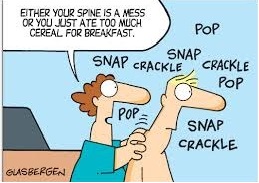Our joints may make noises, such as a snap, crackle,  or pop, at any age. Snapping and popping sounds are often associated with traumatic injury (i.e. ACL tears have a
or pop, at any age. Snapping and popping sounds are often associated with traumatic injury (i.e. ACL tears have a
common pop noise). However, if there is no pain or swelling associated with these noises or snapping sensations, there is no need to be overly concerned. Degenerative changes are normal within or around the joint, especially as we age or with overuse. This can increase the frequency of these sounds coming from the joint.
Our muscles form into tendons to attach to bone. Sometimes these tendons can be under a lot of tension because of the anatomy of the area (around a bony prominence) or the muscles leading into the tendon may be tight. When the muscles lose flexibility due to overuse, underuse, injuries, adhesions, and/or scar tissue, it will pull the tendons taut. Snapping that you can feel or hear in your joints without pain can be tendons rubbing against bone. A similar issue can be related to stretching of ligaments or other structures (i.e. retinaculum) that hold tendons down.
Clicking, crackling or grinding noises, called crepitus, can be heard when osteoarthritis or degenerative joint disease is present. The cartilage between a joint can get worn down over time when movements are aberrant. Also, the fluid inside the joint can become more viscous and increase friction between bone surfaces. The bone surfaces rubbing against each other can produce the crepitus sound.
Non-traumatic popping sounds or cracking (cavitation) of the joints is a normal physiologic response to taking the joint past its elastic barrier. The sound is created when a bubble is formed in a joint capsule. These are the same sounds that you hear with a Chiropractic adjustment. Many people
chronically crack their joints by twisting and bending their neck or low backs. However, these joints are not necessarily the joints that need
to be moved. When a joint is restricted, the joints above and below have to take up the slack and can become hypermobile. These hypermobile joints are most likely the joints you are able to cavitate. This feels good because movement receptors (i.e. mechanoreceptors) are stimulated and reset. As a result, reflexogenic muscle spasms are temporarily relaxed. The difference between self-manipulation and an adjustment from a professional is the doctor is able to find the true restriction/fixation where motion is limited and provide a force to restore motion to that part of the spine.
The best way to keep joints healthy is to keep them moving every day with exercise, strength training, myofascial release/rolling, stretching, and spinal check-ups and adjustments if necessary. Also, it is important to keep the muscles that move these joints limber and symmetrical. Sometimes asymmetrical and repetitive movements
can accelerate degeneration. Carrying a bag on one shoulder or hand, sitting on a wallet in your back pocket, looking down at your phone, slouching, etc. can produce unnecessary wear and tear. At Bedford Hills Family Chiropractic, joints and muscles are our specialties. We can help restricted joints move better with adjustments and improve muscle function using soft tissue techniques.
Dr. Stu